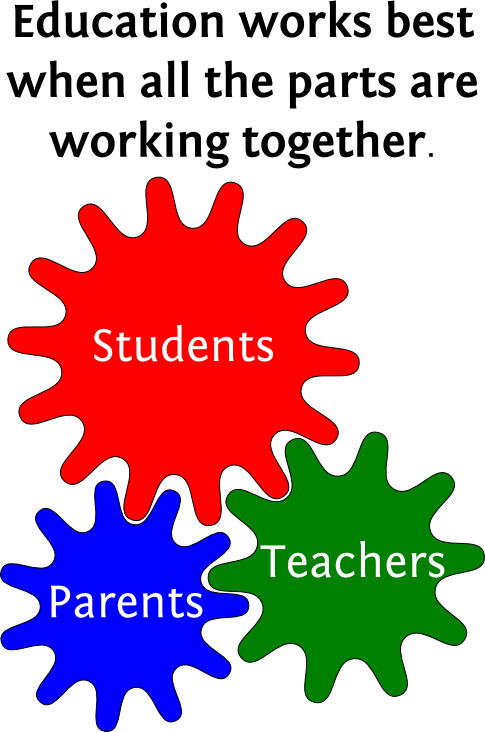Variations of this picture of educational cogs have been widely distributed in schools. Education works best, we are told, when all the parts work together. The picture shows three gears, arranged in a circle. If you remember your studies of mechanics, this arrangement cannot possibly work.
Imagine the first gear turning clockwise; it would drive the second gear counter-clockwise, which would drive the third gear clockwise, which would drive the first counter-clockwise. But the first gear cannot simultaneously go clockwise and counter-clockwise; this circular gear train would be frozen.
It’s sad that an exponent of government schools would mangle a metaphor so badly. But what does this metaphor tell us? Permit me to speculate why the artist chose a circle, rather than a linear train of gears. A circular model suggests that parents, students, and teachers are in a kind of cooperative dance, ring around the rosies. No part drives the others. What is missing from this picture? Administrators, politicians, and the political process. That’s a large omission. Ask any teacher; they’ll tell you how important politics is, how it often trumps the best interests of teachers, students, and parents; how the best teachers often struggle to find ways to work within or to work around the system, in order to do the best they can for the students.
A more important problem, however, is the assumption that participants are mere cogs in an inexorable machine. There is more truth to this analogy than we like to admit. The origins of what we know of as the Prussian Model of Schooling were military; this model of organization was designed by Fichte, in his Addresses to the German Nation, to produce compliant cannon fodder, soldiers who would march into a barrage of fire when ordered to, “theirs not to reason why. Theirs to do and die.” It was organized as a top-down hierarchy, following the pattern of the military. Everyone was assigned specific limited roles to play, including teachers, students, and parents.
Later, as assembly lines became the norm, industrialists sought a labor force who would do as they were told, and not raise too much ruckus. Schools became an assembly line, a pipeline, where children were fed in one end, and emerged, tightly controlled, compliant, ready to follow orders. Rejects were ejected, or subtly encouraged to self-deport. They were labeled “misfits.” But often, these “misfits” accomplish great things. Those who start powerful trends, who change our lives, are seldom the compliant ones.
“A man must consider what a rich realm he abdicates when he becomes a conformist.” – Ralph Waldo Emerson
There is a famous story about young Carl Friedrich Gauss, who was ordered to add the numbers from 1 to 100 when he was only six years old. Moments later, he presented the answer: 5050. The teacher, instead of recognizing the child’s genius, was outraged; his answer did not fit the limited playbook from which the teacher was working. Gauss recognized that the hundred numbers could be easily rearranged into 50 pairs, each of which summed to 101. He quickly performed the simple multiplication. He went off-script, both in being able to discover that insight, and in being able to do multiplication in first grade.
These are the rich possibilities which are blocked off by pedantic teachers, textbooks and processes which force children to abdicate responsibility for their own learning, and guide them into a “safe,” predictable assembly-line.



